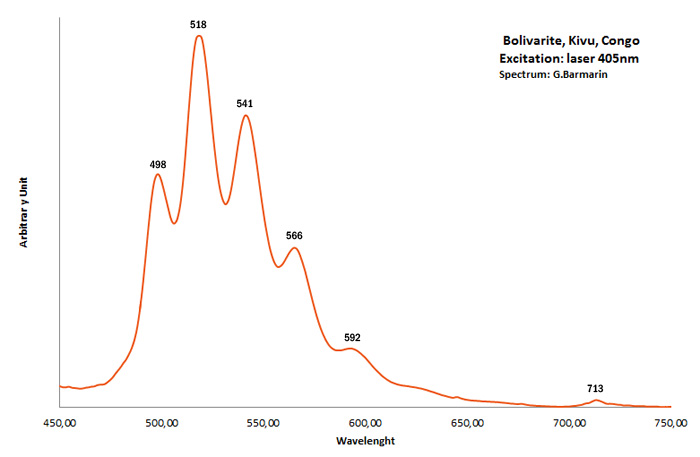Database of luminescent minerals
BOLIVARITE
Chemical formula: See EVANSITE Al2(PO4)(OH)3 4H2O
Family: Phosphates, Arseniates, Vanadates
Status: IMA-GP
Crystal system : Amorphous
Display mineral: NON
Luminescence:
Longwave UV (365nm) colors: |
Green , | ||
Intensity LW:Strong | |||
Midwave UV (320nm) colors: |
Green , | ||
Intensity MW:Strong | |||
Shortwave UV (254nm) colors: |
Green , | ||
Intensity SW:Strong | |||
Do you have a photo of this mineral you would like to see in the gallery? Contact us!
Phosphorescence (in the common sense of the term) observable with the naked eye:
No data
Comments:
Possibly only a variety of evansite (if bolivarite was formally discredited, evansite would have priority as the species name). (See https://www.mindat.org/min-713.html ) See also Kobokoboite
Activator(s) and spectrum:
Activator(s): (UO2)2+ (ion Uranyle) en impureté,
Peaks in the spectrum (nm):
UO22+ : 498, 518, 541, 566, 592nm 713nm

Bolivarite, Kivu, Congo; Excitation: laser 405nm. Col. G. Barmarin; Spectre: G. Barmarin
Best localities for fluorescence (*):
- Kobokobo pegmatite, Shabunda Territory, South Kivu, DR Congo (light green SW);
- Pontevedra, Galicia, Spain (white-green, SW+LW);
(*)The data are not exhaustive and are limited to a few remarkable localities for fluorescence
Bibliographic reference for luminescence:
- The Henkel Glossary of Fluorescent Minerals, Dr. Gerhard Henkel, Published by the FMS, 1989 ,
- Fluorescence: Gems and Minerals Under Ultraviolet Light, Manuel Robbins, 1994, Geoscience Press, ISBN 0-945005-13-X ,
- Luminescenza nel regno minerale, Guido Mazzoleni, fotografia Roberto Appiani, Libri Sandit, 2010, ISBN 978-88-95990-63-7 ,
Reference for luminescence on the Internet:
- A-re-investigation-of-bolivarite-and-evansite, Javier Garcia-Guinea, A. Millan Chagoyen, Ernest H. Nickel, The Canadian Mineralogist (1995) 33 (1): 59–65.
- The uranium-bearing mineral bolivarite: new data and a second occurrence, L. Van Wambeke, Published online by Cambridge University Press: 05 July 2018
Mineralogical reference on the Internet:
 http://www.mindat.org/show.php?name=Bolivarite
http://www.mindat.org/show.php?name=Bolivarite
 http://webmineral.com/data/Bolivarite.shtml
http://webmineral.com/data/Bolivarite.shtml
Internet Search:
 Image search on 'Google Images'
Image search on 'Google Images'
 Search for documents in all languages on Google
Search for documents in all languages on Google
A request providing no result means only that no such reference exists in the database, but it does not mean that what you are looking for does not exist, just not to our knowledge. If you think you have found an error or omission, please let us know via the contact page being sure to cite the source of information.
